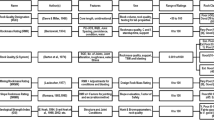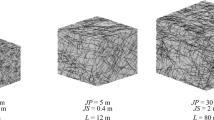Abstract
Understanding exact rock conditions has a significant impact on the success of tunnel construction. Various methods such as Q-systems and rock mass rating (RMR) have been used to estimate the condition of jointed rock mass in fields. However, the evaluation of rock mass characteristics can diverge because of the subjective views of observers. Many researchers that work on the relationship between rock mass classification methods and its physical variables have tried to solve this problem; nevertheless, the accuracy of their studies has become a subject of controversy. Thus, in this study, we tried to evaluate rock mass classification in terms of RMR from the electrical resistivity that is readily affected by the characteristics of jointed rock mass. The relationship between the RMR parameters and the electrical resistivity was deducted using the formula of electrical resistivity analyzed for jointed rock mass. The correlation analyses were performed based on real data (4,689 sets) in order to obtain the degree of correlation among RMR parameters. The results show that some parameters are strongly correlated while other parameters are not. Stochastic analyses show that the theoretical relationship between RMR value and electrical resistivity can be improved by probabilistically removing the irrelevant (low possibility) relation among RMR parameters. Finally, a field test was performed to verify the suggested probabilistic RMR estimation using electrical resistivity.
Similar content being viewed by others
References
Archie GE (1942) The electrical resistivity log as an aid in determining some reservoir characteristics. Transactions of the AIME 146:54–62, DOI: 10.2118/942054-G
Barton N, Lien R, Lunde J (1974) Engineering classification of rock masses for the design of tunnel support. Rock Mechanics 6:189–236, DOI: 10.1007/BF01239496
Bell FG, Jermy CA (2000) The geotechnical character of some South African dolerites, especially their strength and durability quarterly. Journal of Engineering Geology and Hydrogeology 33:59–76, DOI: 10.1144/qjegh.33.1.59
Bieniawski ZT (1973) Engineering classification of jointed rock masses. The Civil Engineers in South Africa 15(12):335–343
Bieniawski ZT (1993) Classification of rock masses for engineering: The RMR system and future trends. Rock Testing and Site Characterization 3:553–573, DOI: 10.1016/B978-0-08-042066-0.50028-8
Carmichael RS (1989) Practical handbook of physical properties of rocks and minerals. CRC Press, Boca Raton, FL, USA
Carter TG (2010) Applicability of classifications for tunnelling–Valuable for improving insight, but problematic for contractual support definition or final design. Proceedings of world tunnel congress (WTC) 2010, May 14–20, Vancouver, Canada
Choi JH, Jo CH, Ryu DW, Kim H, Oh BS, Kang MG, Suh BS (2003) A study on the correlation between the result of electrical resistivity survey and the rock mass classification values determined by the tunnel face mapping. Tunnel and Underground Space 13(4):279–286 (in Korean)
Dearman WR, Baynes FJ, Irfan TY (1978) Engineering grading of weathered granite. Engineering Geology 12:345–374, DOI: 10.1016/0013-7952(78)90018-2
Deere DU (1964) Technical description of rock cores for engineering purpose. Rock Mechanics and Engineering Geology 1:17–22
Doveton JH (1986) Log analysis of subsurface geology: Concepts and computer methods. John Wiley & Sons, Inc., Hoboken, NJ, USA
Duhme R (2017) Designing TBMS for subsea tunnels. Proceedings of the 2017 international conference on tunnels and underground spaces (ICTUS17), August 28-September 1, Ilsan, Korea
Edelbro C, Sjöberg J, Nordlund E (2007) A quantitative comparison of strength criteria for hard rock masses. Tunnelling and Underground Space Technology 22:57–68, DOI: 10.1016/j.tust.2006.02.003
Hoek E, Brown ET (1980) Empirical strength criterion for rock masses. Journal of Geotechnical and Geoenvironmental Engineering 106:1013–1035
Justo JL, Justo E, Azañón JM, Durand P, Morales A (2010) The use of rock mass classification systems to estimate the modulus and strength of jointed rock. Rock Mechanics and Rock Engineering 43:287–304, DOI: 10.1007/s00603-009-0040-6
Kim CY, Yim SB, Jang SH, Lee SW, Kim KY, Park KH (2011) Urban deep road tunnel construction project in Korea and technical requirements. Procedia Engineering 14:3151–3154, DOI: 10.1016/j.proeng.2011.07.397
Kwon HS, Hwang SH, Baek HJ, Kim KS (2008) A study on the correlation between electrical resistivity and rock classification. Geophysics and Geophysical Exploration 11:350–360 (in Korean)
Lee KJ, Ha HS, Ko KB, Kim JS (2009) Investigation of indicator krigingfor evaluating proper rock mass classification based on electrical resistivity and RMR correlation analysis Tunnel and Underground Space 19:407–420 (in Korean)
Li S, Liu B, Xu X, Nie L, Liu Z, Song J, Sun H, Chen L, Fan K (2017) An overview of ahead geological prospecting in tunneling. Tunnelling and Underground Space Technology 63(Supplement C):69–94
Linek M, Jungmann M, Berlage T, Pechnig R, Clauser C (2007) Rock classification based on resistivity patterns in electrical borehole wall images. Journal of Geophysics and Engineering 4:171–183
Littlejohn GS, Cole KW, Mellors TW (1994) Without site investigation ground is a hazard. Proceedings of the Institution of Civil Engineers - Civil Engineering 2:72–78, DOI: 10.1680/icien.1994.26349
Liu J, Elsworth D, Brady BH (1999) A coupled hydromechanical system defined through rock mass classification schemes. International Journal for Numerical and Analytical Methods in Geomechanics 23:1945–1960, DOI: 10.1002/(SICI)1096-9853(19991225)23:15<1945::AID-NAG42>3.0.CO;2-N
Lumb P (1983) Engineering properties of fresh and decomposed igneous rocks from Hong Kong. Engineering Geology 19:81–94, DOI: 10.1016/0013-7952(83)90027-3
Reitz JR, Milford FJ, Christy RW (1979) Foundations of electromagnetic theory, 3rd edition. Addison-Wesley Publishing Company, Boston, MA, USA
Ryu HH (2010) Development of tunnel electrical resistivity prospecting system and its application. PhD Thesis, Korea Advanced Institute of Science and Technology (KAIST), Daejeon, Korea
Ryu HH, Oh TM, Cho GC, Kim KY, Lee KR, Lee DS (2014) Probabilistic relationship between Q-value and electrical resistivity. KSCE Journal of Civil Engineering 18(4):780–786, DOI: 10.1007/s12205-014-0339-z
Shin HS, Kwon YC (2009) Development of a window-shifting ANN training method for a quantitative rock classification in unsampled rock zone. Journal of Korean Tunnelling and Underground Space Association 11(2):151–162 (in Korean)
Tugrul A (2004) The effect of weathering on pore geometry and compressive strength of selected rock types from Turkey. Engineering Geology 75:215–227, DOI: 10.1016/j.enggeo.2004.05.008
Tuğrul A, Zarif IH (1999) Correlation of mineralogical and textural characteristics with engineering properties of selected granitic rocks from Turkey. Engineering Geology 51:303–317, DOI: 10.1016/S0013-7952(98)00071-4
Acknowledgements
This work was supported by the National Research Foundation of Korea (NRF) grant funded by the Korean government (MSIT) (No. 2017R1A5A1014883) and Korea Electric Power Corporation (Grant number: R18XA06-09).
Author information
Authors and Affiliations
Corresponding author
Rights and permissions
About this article
Cite this article
Hong, CH., Ryu, HH., Oh, TM. et al. Probabilistic Rock Mass Rating Estimation Using Electrical Resistivity. KSCE J Civ Eng 24, 2224–2231 (2020). https://doi.org/10.1007/s12205-020-1315-4
Received:
Revised:
Accepted:
Published:
Issue Date:
DOI: https://doi.org/10.1007/s12205-020-1315-4




